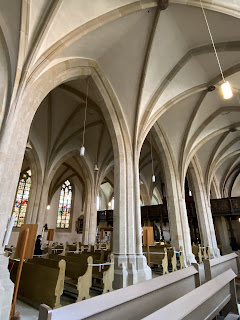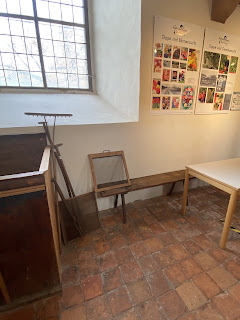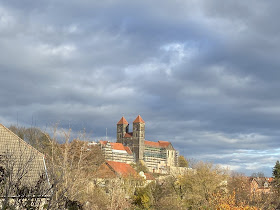Neben den vielen wunderschönen und wunderschön verschiedenen Fachwerkbauten gibt es auch schöne Kirchen in Quedlinburg. Die erste, die mir begegnet ist die Nikolaikirche, sie steht in der Neustadt und wurde um 1200 als romanische Basilika errichtet und ca 100 Jahre später zu einer gotischen Kirche umgebaut, und da das Bauen eine längere Zeit in Anspruch nahm, ist eines der Kirchenschiffe frühgotisch, die beiden anderen spätgotisch. Das Äußere der Kirche ist eher schlicht , darum war ich schwer beeindruckt von der opulenten Erscheinung im Inneren der Kirche, die Glasfenster, der Hochalter, die Kanzel, die von einem Engel getragen wird. Besonders gefallen hat mir der schwebende Engel über dem Taufstein und die durchaus liebevolle Art, mit der einige Kirchenbänke abgesperrt sind, damit die Abstandsregeln wegen der Corona-Pandemie eingehalten werden. Statt des oft verwendeten rot-weißen Plastikbands von der Baustelle gibt es hier weiße, halbtransparente Satinbänder. Und es gab mal einen Pastor hier im 18. Jahrhundert, Johann Christian Erxleben, bekannt und berühmt aber ist seine Frau Dorothea Christiane Erxleben, sie war Ärztin, die erste in Deutschland, sie hat 1754 promoviert und als Ärztin in Quedlinburg gearbeitet und zusammen mit anderen dafür gekämpft, dass Frauen im Hörsaal fast überall auf der Welt heute eine Normalität sind.
In der Nähe des Rathauses gibt es die Marktkirche St. Benedikti, eine gotische Hallenkirche, deren romanischer Vorgängerbau 1173 geweiht wurde, einige wenige romanische Bauelemente sind noch erhalten. Weit beeindruckender ist der gotische Hochaltar im Chor und die beiden Flügelaltare. Einer, von 1500 stammend, von einem unbekannten Künstler erschaffen, erstrahlt wieder in alter, neuer Pracht, da er gerade renoviert wurde. Dabei wurden die beiden Flügel zum ersten Mal seit vermutlich Jahrzehnten oder länger zugeklappt und man (wieder)entdeckte die Bemalung darauf, die Szenen aus dem Leben des Namenspatrons der Kirche darstellen. Leider gibt es keine Bilder davon. Auf Nachfrage meinte die Dame am Eingang, sie würden die Bilder auch noch nicht kennen. Aber auch ohne diesen Überraschungsfund ist der Alter ein wahres Kleinod, eine Pieta im Mittelteil und auf den beiden Flügeln diverse Heilige, die fast alle als Nothelfer bezeichnet werden. Außerdem gibt es eine Darstellung des Heiligen Martin, des Heiligen Antonius und der Heiligen Scholastika, der Zwillingsschwester des Heiligen Benedikt (wieder was gelernt) in der Predella (Sockel) des Altars. Einen weiteren Flügelaltar gibt es in der Kalandskapelle, ein Marienaltar, Mutter mit Kind umgeben von lauter anderen Frauen. Der Altar hat mir besonders gefallen. Am Eingang zur Kapelle hat sich König David mit seiner Harfe positioniert und nun habe ich den Song von Leonard Cohen ‚Halleluja‘ im Kopf, wo er von dem völlig erstaunten König David, der das Halleluja komponiert, singt. Dieser König David sieht auch etwas verwundert aus, vielleicht fragt er sich, wo die Orgel ist, die er einst gestürzt hat. Ein anderes Schmuckstück ist die hölzerne Kanzel aus der Spätrenaissance, im Original von 1595 sah sie vermutlich anders farbig aus, denn bei einer Renovierung im Jahr 1885 wurde etwas Marmor aufgetragen, weil, das fand man damals schick.
Nun muss ich noch die Stiftskirche besuchen, und auf dem Weg dorthin begegnet mir, die Kirche St.Blasii, deren Vorgängerbau aus dem 10.Jahrhundert stammt. Die Kirche ist heute noch ein Kirchenbau, aber wird als Museum und Kulturstätte genutzt. Im Moment gibt es eine Ausstellung über Gartenbau und Saatzucht für Blumen und Gemüse. Die Kirche ist eher klein, aber sehr beeindruckend im Innenraum. Es gibt eine Hufeisenempore und einen Kanzelaltar. So etwas habe ich noch nicht gesehen, bei der Predigt steigt der Pfarrer durch den Altar in die Kanzel und die Altarfiguren sind dann irgendwie die Illustration für seine Worte. Cool. Die Deckenbemalung ist barock, sowie auch der Altar und das Kirchengestühl ist alt und sieht aus wie lauter einzelne Boxen, in die die Kirchenbesucher hineingesteckt wurden. Auf Grund der Exponate der Ausstellung hatte ich die Assoziation von Anzuchtkästen, an den Wänden wird erzählt, wie Samen von Blumen gezogen werden und in den Kirchenbänke wurden neue Gläubige angezüchtet, was irgendwie passt, denn hier predigte seinerzeit Johann August Ephraim Goeze, der Pfarrer und Zoologe war. Das Mausoleum seiner Familie befindet sich gegenüber der Marktkirche.
Nun aber, die Stiftskirche. St. Servatii oder auch Quedlinburger Dom ist eine romanische Basilika und war die Kirche des Quedlinburger Damenstifts. Die dreischiffige Basilika wurde zwischen 1070 und 1129 errichtet und ist Teil des UNESCO Weltkulturerbes, außerdem geschütztes durch die Haager Konvention und durch jede Menge Bauplanen. Viel mehr gibt es hier nicht zu sehen, für den ermäßigten Preis von 4€ durfte man den Domschatz und die Kirche von innen und die Krypta sehen. Sehr interessant fand ich die Metallverkleidungen mit den beschichteten Textilbehängen und der futuristischen Jesus-am-Kreuz-Darstellung, nee, Moment mal, das sind die Baugerüste und Abdeckungen. Habe ich gerade 4€ bezahlt, um eine Baustelle zu sehen? Wow! Etwas Domschatz gab es auch, Fotos verboten und passend zum Moment einen Reliquienschrein der Heiligen Corona. Ob die Kirche imposant ist, kann ich nun nicht verlässlich beurteilen, die Bauplanen waren eher gewöhnlich und der Domschatz so naja, bin natürlich auch etwas verwöhnt aus Trier gekommen. Aber vom Berg, oder Hügel auf dem die Stiftskirche steht hat man einen schönen Rundumblick über die Stadt.
Es gibt noch eine Kirche, die etwas abseits der Touristenpfade liegt, aber auf den Hinweisschildern immer erscheint, St. Wiperti. Gut versteckt, wenn man nicht weiß, wo sie ist, leicht zu finden, wenn man sie kennt. Eine einschiffige Hallenkirche romanischen Ursprungs mit einer Kryta aus dem 10. Jahrhundert, umgeben von einem schönen Friedhof. Ich schau mich erstmal um, Kirche von rechts, von links und von vorne und stelle fest, die Tür ist verschlossen. Da hat mich das Internet mit Fehlinformationen versorgt. Aber nun bin ich schon mal hier und darum frage ich ganz beherzt einen freundlichen Friedhofsgärtner, ob denn die Kirche nicht zu besichtigen sei heute. Nein, die wäre nur bis zum 31.10. geöffnet, danach ist Winterschlaf, also Winterpause, und hätte ich doch mal vorhin die Leute mit den Fahrrädern gefragt, als ich gekommen bin. Ich sehe, ich muss noch einiges lernen, zum Beispiel, in die Vergangenheit reisen, um etwas anders zu machen. Dann noch schnell ein paar Fotos durch die Kirchenfenster und von der Tür, als diese sich öffnet. Die Leute mit den Fahrrädern. Na, wie hab ich das gemacht? Nun muss ich nur noch fragen, und schon stehe ich in der Kirche. Ein sehr eindrucksvoller Dachbau als Gegensatz zu schlichten Innenausstattung der katholischen Kapelle. Leider, so der Mann mit Fahrrad, seie er knapp mit der Zeit und könnte mir nun nicht die Krypta zeigen, ob ich denn nicht im Mai wiederkommen wolle, da wäre die Kirche wieder geöffnet. Ich glaube, das will ich.
English version below
Beside many beautiful and beautifully different half-timbered houses there are great churches in Quedlinburg as well. The first one I meet is Nikolai-Church in the New Town of Quedlinburg, it’s erected as a Roman basilica around 1200 and 100 years later renewed and turned into a gothic church, and since building took awhile one nave is early gothic style and the other both are late gothic. The outside appearance is more plain that’s why I was a bit flashed by the opulent inside ornaments, the stained glass windows, the high altar, the pulpit carried by an angel. I liked most the floating angel over the font and the lovely way they blocked some of the church pews to fulfil the distance regulations because of corona pandemic, it’s not the red-white plastic band you find at construction sites, but white, semitransparent satin ribbons. And once, in the 18th century there was a pastor with name Johann Christian Erxleben, but really famous was his wife, Dorothea Christiane Erxleben, she was the first female physician in Germany, did her Ph.D. in 1754 and worked as a doctor in Quedlinburg since then and was fighting among others, that nearly everywhere now women at university are something normal.
Near the city hall we find the church St. Benedikti, a Gothic hall church, erected on the remains of a Roman church, which was sanctified in 1173, some Roman architectural elements are still to be seen. Way more impressive is the gothic high altar in the apse and the both winged altars. One of them, from the 1500s by an unknown artist is back to old glory after renovation. During this work they had to flap the both wings for the first time in hundreds of years and realised they are covered with paintings about the life of the patron of the church. Unfortunately there are no pictures of them and the lady at the entry said, they didn’t saw them too until now. But even without this surprise the altar is a real gem, in the middle a pietà, and at both wings holy people mostly named as helper when needed and in the predella (base of altar) Saint Martin, Saint Antonius and Saint Scholastica, twin sister of Saint Benedikt (learned something new here). There is another winged altar in Kaland-Chapel, an altar dedicated to Maria, and mother and child are surrounding by other women, I love this one. At the entry to the chapel King David is playing his harp and instantly the song ‘Hallelujah’ by Leonard Cohen came to my mind, where he sings about the buffled king composing Hallelujah. The King David here looks a bit surprised too, maybe he is asking himself where the organ is he once buttressed. Another piece of beauty is the wooden pulpit from late renaissance era, colour-wise the pulpit might have looked different in 1595, because in 1895 while renovating it they added some marble design, since they liked it this way at this time.
Now I need to see the Collegiate Church, but on my way I meet St. Blasii, which’s predecessor building is from the 10th century. It’s still a church (building) but not a working church anymore but a cultural place for exhibitions and concerts. At the moment there is a exhibition about gardening and seed breeding for flowers and vegetables. The church is not that huge, but impressive inside. There is a horse shoe shaped gallery and a pulpit-altar. I’ve never seen this before, for the sermon the preacher climbs through the altar to get to the pulpit and the figures at the altar are kind of an illustration for his words. Cool. The mural on the ceiling is baroque like the altar too and the church pews are old and look like boxes where the church goers will be put in. And because of the exhibition I had the connection between seedling trays, the exhibits telling about seeding new plants and in the pews they are seeding new believers. And it somehow fits, since pastor Johann August Ephraim Goeze was once preaching here, he was a preacher and zoologist. The mausoleum of his family is opposite the church St. Benedikti.
Collegiate Church, next try. St. Servatii or Quedlinburg Cathedral is a Roman basilica and was the church of the Quedlinburg Lady’s Collegiate. The three-nave basilica was built between 1070 and 1129 and is part of UNESCO world cultural heritage, protected also by Haag convention and a lot of construction sheets. There isn’t much more to be seen at the moment. For the construction discount price of 4€ you can visit the inside of the church, the treasure and the crypt. Very interesting those metal frames with plastic covered textiles and a futuristic looking Jesus-at-cross-installation, no, wait, that’s construction sheets as well, isn’t it. Did they really made me pay 4€ to visit a construction site? Wow! There was a bit church treasure to be seen too, taking pictures not allowed and one reliquary was dedicated to the Saint Corona, that’s fits. If the church is impressive, I can’t tell, the construction sheets look quite ordinary and the treasure room is fair to middling, but I’m spoiled rotten by Trier, but from the hill the church is located on top you have a great view onto the city.
There is another church, a bit offside the main tourist routes, but it’s mentioned in many signposts, St. Wiperti. It’s well hidden, if you don’t know where to search and easy to find, when you know where to look. A one nave hall church of Roman origin surrounded by a beautiful churchyard. I first look around, church from the right side, from the left side, the door, closed. I thought it’s open, due to fake news from the internet, but since I already here, I’m asking the friendly gardener if the church is already closed. Yes, indeed, since November 1st it’s hibernating, because no heating. And why haven’t I asked those folks on bicycles when I arrived. I see, I have to learn new things, like travelling in time to do things I didn’t do in first place. So, quick some pictures through the church windows and from the door, that suddenly was opened, by the people with the bicycles. How did I do that! Now I only need to ask and I’m in. A very impressive wooden ceiling and opposite a plain and simple interior of the catholic chapel. The man with the bicycle said, he is short of time, that’s why he can’t show the crypt right now and if I don’t mind coming back in May, then they open again. I guess I don’t mind.





























































Keine Kommentare:
Kommentar veröffentlichen